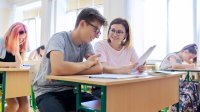4 Tips for a Successful Self-Contained Classroom
Co-teachers in a special education classroom focus on building a community of learners with a focus on real-world skills.
Your content has been saved!
Go to My Saved Content.The self-contained classroom has been deemed the most exclusive learning environment within a school, a place where special education teachers are able to accommodate individual students who typically exhibit the greatest learning challenges as a result of significant cognitive, emotional, and/or physical delays.
While a self-contained classroom offers features such as smaller class size and higher staff-to-student ratio, what students tend to value most is the comfort of a close-knit community for learning. In our co-taught self-contained high school classroom, we’ve found success by embracing a culture that embodies opportunity for students to share, think, and develop unified success. We promote the idea that students should take initiative and pride in being part of a community, and should take on responsibilities.
We focus on real-world applications, and work to impart skills that students with learning disabilities will need in their lives after high school.
The planning and implementation that go into a self-contained classroom take a lot of commitment, but with the right mindset, this type of classroom can become a place for growth on all levels.
4 Strategies We Focus On in Our Self-Contained Classroom
1. Create a sense of community: Building and maintaining strong relationships with students, parents, and colleagues goes a long way. We are lucky to work with highly committed support staff who are willing to be trained and follow through with expectations, and this is crucial. Collaboration on shared expectations is invaluable.
We start by getting to know students’ interests, strengths, and needs—not only from the IEP, but through interest inventories and conversations with students, parents, and previous teachers. We also reach out to families early on and continuously throughout the year, inviting and welcoming parent feedback. And we share students’ successes, not just their challenges or concerns.
We collaborate with other teachers across disciplines to make our program more inclusive. For example, we work with English, history, and science teachers to connect ideas such as the sequencing of events like geological events. We connect that to the sequencing of events in a story, and use a timeline like they do in history class. We have also collaborated with the art classes to have students make a model of the life sequence of a star or layers of rock when we study those concepts.
We also work to connect our students to their peers through our peer mentorship program, where students can earn credits for serving as buddies for our students. Peer mentors are assigned to a self-contained class, assist students with activities within the class, accompany them on community-based trips, eat lunch with them, and lead extracurricular events including dances, game nights, and other events, all of which foster a sense of belonging and community.
2. Establish routines, but encourage flexibility: When students are taught the importance of routines and also how to be flexible in certain situations, they are more prepared for life after school.
We divide our class periods into learning blocks. This allows for structured movement while opening up the idea of being flexible in learning material in different ways. We also encourage flexibility by offering students choice and differentiation in learning.
We start each day with a check-in. This routine helps us gain perspective about each and every student in the room and allows us to gauge students’ level of energy, focus, and readiness to learn. We end class with an exit ticket. It doesn’t have to be about what they have learned—sometimes it’s a simple statement on how each student feels after a lesson or activity.
Providing choices for students is important—allowing them to show their understanding of a concept through creating a game, drawing a picture, completing a worksheet, or discussing it within a group helps improve their engagement with content. We also revisit and practice important content and skills daily; reinforcing the skills within a subject such as mathematics helps students build working memory.
3. Employ varied instructional approaches: Varying instructional approaches in the classroom offers opportunities for students to learn in different ways and helps keep their engagement level up.
We integrate learning stations often to encourage physical movement, opportunities to differentiate, and exploration of concepts through different mediums. We also like to provide opportunities for the students to teach and create—when they attempt to teach concepts, they gain a better understanding of the material.
Varying instructional materials is another way to boost engagement, and we frequently switch between hands-on activities, computer apps, and lab and data collection activities. We also try to make learning fun by setting up games and fun activities with tools like Kahoot and Quizlet to reinforce skills while keeping things enjoyable.
4. Integrate community-based instruction (CBI): When students are immersed in a specific setting they often learn more. An example of this is taking students out into the community to develop useful skills. This allows them to see real-world situations they will encounter after school.
We offer students the opportunity to assist with local fundraisers, agencies, and community support systems by connecting with nonprofits, libraries, and organizations like United Way. This helps foster a sense of belonging and encourages them to become contributing members of society. Some examples are helping out at local agencies, learning about a community garden, working at a food bank, performing at a senior center, and making a craft with seniors.
We also elicit community support to offer extracurricular activities like sports teams and clubs that include students with and without intellectual disabilities—for example, our cheerleaders teach students who want to learn how to cheer, and they perform at halftime for unified basketball games.
